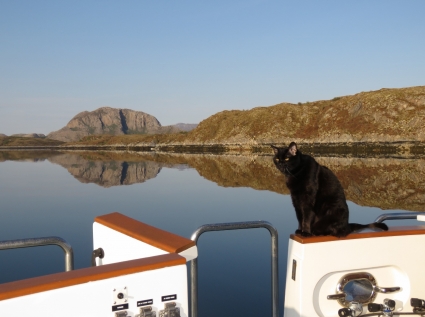Long-range cruising is one thing; long-range cruising with a pet is another. But James and Jennifer Hamilton have managed to make all this seem easy, as they’ve been cruising – literally around the world – with their cat Spitfire ever since they left Seattle on their Nordhavn 52 Dirona in 2012. The Hamiltons, who now are in Amsterdam, have written an account of life on board with Spitfire on their blog, MVDirona.com. Here’s how they – and Spitfire – have managed so far:
When we first started planning our boat trip around the world, we expected that cruising internationally with our cat Spitfire would limit the countries we could visit, because we did not want to subject him to lengthy quarantines. In reality, the French territory of New Caledonia was the only destination that we opted not to visit due to quarantine requirements. In the seven years since we left Seattle in 2012 to travel around the world, Spitfire was only quarantined a single time, for ten days in New Zealand.
Entry rules vary between countries, but the most common requirements are that pets have a recent international health certificate, be microchipped and be vaccinated against rabies. Some locations, such as Hawaii and New Zealand, have a strict import process that also requires a titer test to show proof of immunity to rabies. These treatments, tests and import approvals can take several months, so if you are considering travelling internationally with your pet, get started early with a microchip and rabies vaccination. These are a good thing to do anyway, so the effort is not wasted if you end up not requiring them. Obtain stamped or signed paperwork for any vaccinations and be sure to keep the originals.
We also recommend reading Where There Is No Pet Doctor by David Lavigne. We bought it mostly for medical purposes, but it turned out to have an excellent section on preparing a pet for international travel. For example, from it we learned that the microchip Spitfire had was US-specific. Countries such as New Zealand now have scanners that will read a US chip, but the scanners in many countries won’t detect it. We got Spitfire an international chip to be on the safe side.
And after a couple of scares where a government veterinarian’s scanner malfunctioned, notably on arrival into Hawaii, we bought our own scanner, a Datamars Micromax that reads international microchips. We’ve never had to use it, but the scanner is good insurance for just over $100.
Cruising internationally with a pet definitely adds some logistic complexity to the trip, but we love having Spitfire with us and the overhead is more than worth it.
The majority of the countries we visited had well-documented entry procedures for pets, but most were oriented towards travel on commercial carriers, where arrival times are predictable and the travel duration is measured in hours. When arriving by boat, travel dates are weather dependent and the trip duration is measured in days or weeks. We sometimes had to negotiate with officials to allow for longer travel windows. We researched in advance the clearance requirements and fees, then contacted local officials to confirm our understanding. A record of our correspondence with officials smoothed our entry on several occasions. Read more:
https://mvdirona.com/2019/12/spitfire-arraow-the-world/




